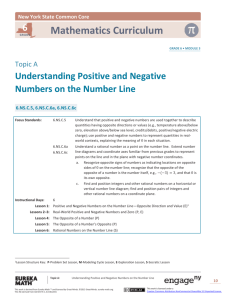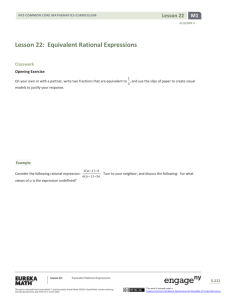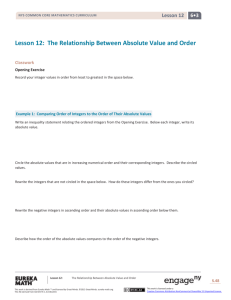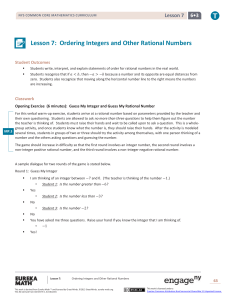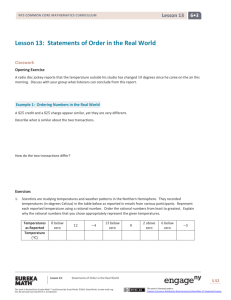Lesson 8: Ordering Integers and Other Rational Numbers
advertisement
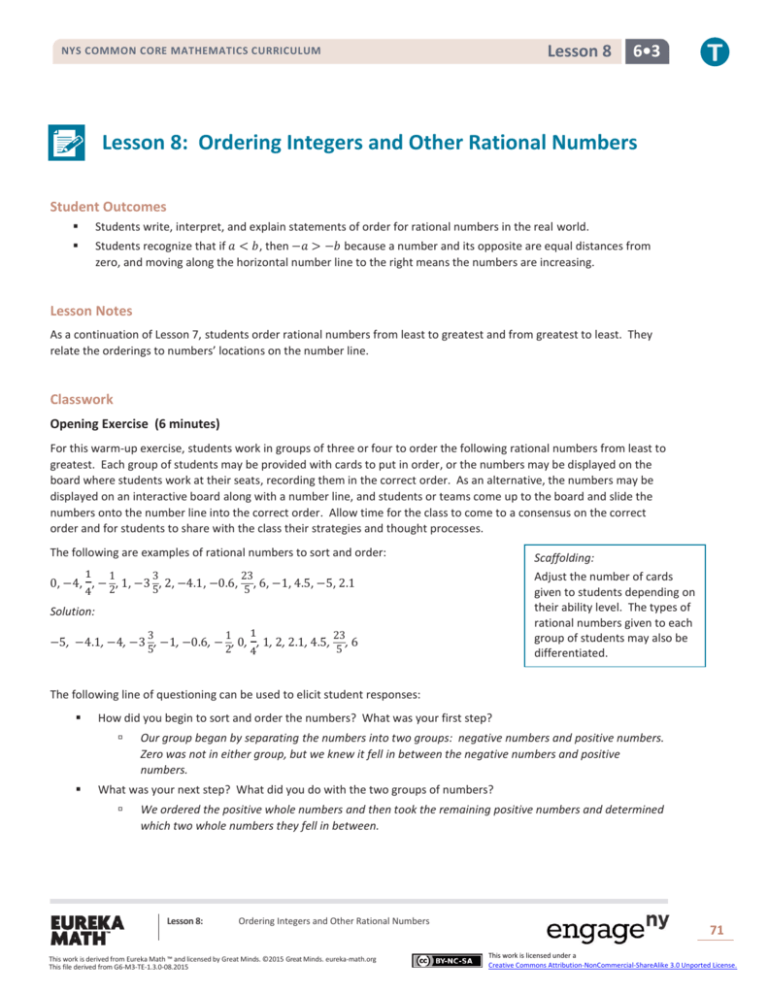
Lesson 8 NYS COMMON CORE MATHEMATICS CURRICULUM 6•3 Lesson 8: Ordering Integers and Other Rational Numbers Student Outcomes Students write, interpret, and explain statements of order for rational numbers in the real world. Students recognize that if 𝑎 < 𝑏, then −𝑎 > −𝑏 because a number and its opposite are equal distances from zero, and moving along the horizontal number line to the right means the numbers are increasing. Lesson Notes As a continuation of Lesson 7, students order rational numbers from least to greatest and from greatest to least. They relate the orderings to numbers’ locations on the number line. Classwork Opening Exercise (6 minutes) For this warm-up exercise, students work in groups of three or four to order the following rational numbers from least to greatest. Each group of students may be provided with cards to put in order, or the numbers may be displayed on the board where students work at their seats, recording them in the correct order. As an alternative, the numbers may be displayed on an interactive board along with a number line, and students or teams come up to the board and slide the numbers onto the number line into the correct order. Allow time for the class to come to a consensus on the correct order and for students to share with the class their strategies and thought processes. The following are examples of rational numbers to sort and order: 1 1 2 3 5 0, −4, , − , 1, −3 , 2, −4.1, −0.6, 4 Scaffolding: 23 , 6, −1, 4.5, −5, 2.1 5 Adjust the number of cards given to students depending on their ability level. The types of rational numbers given to each group of students may also be differentiated. Solution: 3 5 1 2 1 −5, −4.1, −4, −3 , −1, −0.6, − , 0, , 1, 2, 2.1, 4.5, 4 23 ,6 5 The following line of questioning can be used to elicit student responses: How did you begin to sort and order the numbers? What was your first step? Our group began by separating the numbers into two groups: negative numbers and positive numbers. Zero was not in either group, but we knew it fell in between the negative numbers and positive numbers. What was your next step? What did you do with the two groups of numbers? We ordered the positive whole numbers and then took the remaining positive numbers and determined which two whole numbers they fell in between. Lesson 8: Ordering Integers and Other Rational Numbers This work is derived from Eureka Math ™ and licensed by Great Minds. ©2015 Great Minds. eureka-math.org This file derived from G6-M3-TE-1.3.0-08.2015 71 This work is licensed under a Creative Commons Attribution-NonCommercial-ShareAlike 3.0 Unported License. Lesson 8 NYS COMMON CORE MATHEMATICS CURRICULUM How did you know where to place Since 1 4 1 4 and 23 5 6•3 ? is less than a whole (1) but greater than zero, we knew the rational number was located between 0 and 1. We know that 23 5 3 5 is the same as 4 , which is more than 4 but less than 5, so we knew the rational number was located between 4 and 5. How did you order the negative numbers? First, we started with the negative integers: −5, −4, and −1. −5 is the least because it is farthest left at 5 units to the left of zero. Then came −4, and then came −1, which is only 1 unit to the left of zero. How did you order the negative non-integers? 1 2 5 6 , which is to the right of −0.6 (or − ) since −0.5 is closer to zero 10 10 3 than −0.6. Then, we ordered −4.1 and −3 . Both numbers are close to −4, but −4.1 is to the left of 5 3 −4, and −3 is to the right of −4 and to the left of −3. Lastly, we put our ordered group of negative 5 We know − is equivalent to − numbers to the left of zero and our ordered group of positive numbers to the right of zero and ended up with 3 5 1 2 1 −5, −4.1, −4, −3 , −1, −0.6, − , 0, , 1, 2, 2.1, 4.5, 4 23 , 6. 5 Exercise 1 (8 minutes) 1. Students are each given four index cards or small slips of paper. Each student must independently choose four noninteger rational numbers and write each one on a slip of paper. At least two of the numbers must be negative. 2. Students order their rational numbers from least to greatest by sliding their slips of paper into the correct order. The teacher walks around the room to check for understanding and to provide individual assistance. Students may use the number line in their student materials to help determine the order. 3. Once all students have arranged their numbers into the correct order, they shuffle them and then switch with another student. 4. Students arrange the new set of cards they receive into the correct order from least to greatest. 5. The pairs of students who exchanged cards discuss their solutions and come to a consensus. Example 1 (3 minutes): Ordering Rational Numbers from Least to Greatest Example 1: Ordering Rational Numbers from Least to Greatest Sam has $𝟏𝟎. 𝟎𝟎 in the bank. He owes his friend Hank $𝟐. 𝟐𝟓. He owes his sister $𝟏. 𝟕𝟓. Consider the three rational numbers related to this story of Sam’s money. Write and order them from least to greatest. −𝟐. 𝟐𝟓, −𝟏. 𝟕𝟓, 𝟏𝟎. 𝟎𝟎 Lesson 8: Scaffolding: Provide a number line diagram for visual learners to help them determine the numbers’ order. Ordering Integers and Other Rational Numbers This work is derived from Eureka Math ™ and licensed by Great Minds. ©2015 Great Minds. eureka-math.org This file derived from G6-M3-TE-1.3.0-08.2015 72 This work is licensed under a Creative Commons Attribution-NonCommercial-ShareAlike 3.0 Unported License. Lesson 8 NYS COMMON CORE MATHEMATICS CURRICULUM Explain the process you used to determine the order of the numbers. 6•3 There is only one positive number, 10.00, so I know that 10.00 is the greatest. I know 2.25 is farther to the right on the number line than 1.75; therefore, its opposite, −2.25, will be farther to the left than the opposite of 1.75. This means −2.25 is the least, and −1.75 is between −2.25 and 10.00. How would the order change if you were asked to write the numbers from greatest to least? The order would be reversed. I would list the numbers so that the number that comes first is the one farthest to the right on the number line, and the number that comes last is the one farthest to the left on the number line. The order would be 10.00 (the greatest), followed by −1.75, and then followed by −2.25 (the least). Exercises 2–4 (10 minutes) Allow time for students to share their answers with the class and explain their reasoning. Exercises 2–4 For each problem, list the rational numbers that relate to each situation. Then, order them from least to greatest, and explain how you made your determination. 2. During their most recent visit to the optometrist (eye doctor), Kadijsha and her sister, Beth, had their vision tested. Kadijsha’s vision in her left eye was −𝟏. 𝟓𝟎, and her vision in her right eye was the opposite number. Beth’s vision was −𝟏. 𝟎𝟎 in her left eye and +𝟎. 𝟐𝟓 in her right eye. −𝟏. 𝟓𝟎, −𝟏. 𝟎𝟎, 𝟎. 𝟐𝟓, 𝟏. 𝟓𝟎 The opposite of −𝟏. 𝟓𝟎 is 𝟏. 𝟓𝟎, and 𝟏. 𝟓𝟎 is farthest right on the number line, so it is the greatest. −𝟏. 𝟓𝟎 is the same distance from zero but on the other side, so it is the least number. −𝟏. 𝟎𝟎 is to the right of −𝟏. 𝟓𝟎, so it is greater than −𝟏. 𝟓𝟎, and 𝟎. 𝟐𝟓 is to the right of −𝟏. 𝟎𝟎, so it is greater than −𝟏. 𝟎𝟎. Finally, 𝟏. 𝟓𝟎 is the greatest. 3. There are three pieces of mail in Ms. Thomas’s mailbox: a bill from the phone company for $𝟑𝟖. 𝟏𝟐, a bill from the electric company for $𝟔𝟕. 𝟓𝟓, and a tax refund check for $𝟐𝟓. 𝟖𝟗. (A bill is money that you owe, and a tax refund check is money that you receive.) −𝟔𝟕. 𝟓𝟓, −𝟑𝟖. 𝟏𝟐, 𝟐𝟓. 𝟖𝟗 The change in Ms. Thomas’s money is represented by −𝟑𝟖. 𝟏𝟐 due to the phone bill, and −𝟔𝟕. 𝟓𝟓 represents the change in her money due to the electric bill. Since −𝟔𝟕. 𝟓𝟓 is farthest to the left on the number line, it is the least. Since −𝟑𝟖. 𝟏𝟐 is to the right of −𝟔𝟕. 𝟓𝟓, it comes next. The check she has to deposit for $𝟐𝟓. 𝟖𝟗 can be represented by 𝟐𝟓. 𝟖𝟗, which is to the right of −𝟑𝟖. 𝟏𝟐, and so it is the greatest number. MP.2 4. Monica, Jack, and Destiny measured their arm lengths for an experiment in science class. They compared their arm lengths to a standard length of 𝟐𝟐 inches. The listing below shows, in inches, how each student’s arm length compares to 𝟐𝟐 inches. Monica: − Jack: 𝟏 𝟏 𝟖 𝟑 𝟒 Destiny: − 𝟏 𝟐 𝟏 𝟏 𝟑 − , − ,𝟏 𝟐 𝟖 𝟒 𝟏 𝟐 𝟏 𝟖 I ordered the numbers on a number line, and − was farthest to the left. To the right of that was − . Lastly, 𝟏 𝟖 𝟑 𝟒 𝟑 𝟒 𝟏 is to the right of − , so 𝟏 is the greatest. Lesson 8: Ordering Integers and Other Rational Numbers This work is derived from Eureka Math ™ and licensed by Great Minds. ©2015 Great Minds. eureka-math.org This file derived from G6-M3-TE-1.3.0-08.2015 73 This work is licensed under a Creative Commons Attribution-NonCommercial-ShareAlike 3.0 Unported License. Lesson 8 NYS COMMON CORE MATHEMATICS CURRICULUM 6•3 Example 2 (3 minutes): Ordering Rational Numbers from Greatest to Least Example 2: Ordering Rational Numbers from Greatest to Least Jason is entering college and has opened a checking account, which he will use for college expenses. His parents gave him $𝟐𝟎𝟎. 𝟎𝟎 to deposit into the account. Jason wrote a check for $𝟖𝟓. 𝟎𝟎 to pay for his calculus book and a check for $𝟐𝟓. 𝟑𝟒 to pay for miscellaneous school supplies. Write the three rational numbers related to the balance in Jason’s checking account in order from greatest to least. 𝟐𝟎𝟎. 𝟎𝟎, −𝟐𝟓. 𝟑𝟒, −𝟖𝟓. 𝟎𝟎 Explain the process you used to determine the order of the numbers. There was only one positive number, 200.00, so I know that 200.00 is the greatest. I know 85.00 is farther to the right on the number line than 25.34, so its opposite, −85.00, will be farther to the left than the opposite of 25.34. This means −85.00 is the least, and −25.34 would be between −85.00 and 200.00. Exercises 5–6 (6 minutes) Allow time for students to share their answers with the class and explain their reasoning. Exercises 5–6 For each problem, list the rational numbers that relate to each situation in order from greatest to least. Explain how you arrived at the order. 5. The following are the current monthly bills that Mr. McGraw must pay: $𝟏𝟐𝟐. 𝟎𝟎 Cable and Internet $𝟕𝟑. 𝟒𝟓 Gas and Electric $𝟒𝟓. 𝟎𝟎 Cell Phone −𝟒𝟓. 𝟎𝟎, −𝟕𝟑. 𝟒𝟓, −𝟏𝟐𝟐. 𝟎𝟎 Because Mr. McGraw owes the money, I represented the amount of each bill as a negative number. Ordering them from greatest to least means I have to move from right to left on a number line. Since −𝟒𝟓. 𝟎𝟎 is farthest right, it is the greatest. To the left of that is −𝟕𝟑. 𝟒𝟓, and to the left of that is −𝟏𝟐𝟐. 𝟎𝟎, which means −𝟏𝟐𝟐. 𝟎𝟎 is the least. 6. 𝟏 𝟑 𝟏 𝟓 − , 𝟎, − , 𝟏 𝟖 𝟏 𝟏 𝟏 , 𝟎, − , − 𝟖 𝟓 𝟑 I graphed them on the number line. Since I needed to order them from greatest to least, I moved from right to left to 𝟏 record the order. Farthest to the right is , so that is the greatest value. To the left of that number is 𝟎. To the left 𝟏 𝟓 𝟏 𝟑 𝟖 of 𝟎 is − , and the farthest left is − , so that is the least. Lesson 8: Ordering Integers and Other Rational Numbers This work is derived from Eureka Math ™ and licensed by Great Minds. ©2015 Great Minds. eureka-math.org This file derived from G6-M3-TE-1.3.0-08.2015 74 This work is licensed under a Creative Commons Attribution-NonCommercial-ShareAlike 3.0 Unported License. NYS COMMON CORE MATHEMATICS CURRICULUM Lesson 8 6•3 Closing (3 minutes) If three numbers are ordered from least to greatest and the order is 𝑎, 𝑏, 𝑐, what would the order be if the same three numbers were arranged in order from greatest to least? How did you determine the new order? 𝑐, 𝑏, 𝑎 This is the correct order because it has to be exactly the opposite order since we are now moving right to left on the number line, when originally we moved left to right. How does graphing numbers on a number line help us determine the order when arranging the numbers from greatest to least or least to greatest? Using a number line helps us order numbers because when numbers are placed on a number line, they are placed in order. Lesson Summary When we order rational numbers, their opposites are in the opposite order. For example, if 𝟕 is greater than 𝟓, −𝟕 is less than −𝟓. Exit Ticket (6 minutes) Lesson 8: Ordering Integers and Other Rational Numbers This work is derived from Eureka Math ™ and licensed by Great Minds. ©2015 Great Minds. eureka-math.org This file derived from G6-M3-TE-1.3.0-08.2015 75 This work is licensed under a Creative Commons Attribution-NonCommercial-ShareAlike 3.0 Unported License. Lesson 8 NYS COMMON CORE MATHEMATICS CURRICULUM Name 6•3 Date Lesson 8: Ordering Integers and Other Rational Numbers Exit Ticket Order the following set of rational numbers from least to greatest, and explain how you determined the order. 1 2 1 3 −3, 0, − , 1, −3 , 6, 5, −1, Lesson 8: 21 Ordering Integers and Other Rational Numbers This work is derived from Eureka Math ™ and licensed by Great Minds. ©2015 Great Minds. eureka-math.org This file derived from G6-M3-TE-1.3.0-08.2015 5 ,4 76 This work is licensed under a Creative Commons Attribution-NonCommercial-ShareAlike 3.0 Unported License. Lesson 8 NYS COMMON CORE MATHEMATICS CURRICULUM 6•3 Exit Ticket Sample Solutions Order the following set of rational numbers from least to greatest, and explain how you determined the order. 𝟏 𝟏 −𝟑, 𝟎, − 𝟐, 𝟏, −𝟑 𝟑, 𝟔, 𝟓, −𝟏, −𝟏𝟎 −𝟗 −𝟖 −𝟕 −𝟔 −𝟓 −𝟒 −𝟑 −𝟐 −𝟏 𝟎 𝟏 𝟑 𝟏 𝟏 𝟐 𝟐𝟏 𝟓 𝟐 −𝟑 , −𝟑, −𝟏, − , 𝟎, 𝟏, 𝟒, ,𝟒 𝟑 𝟒 𝟓 𝟔 𝟕 𝟖 𝟗 𝟏𝟎 𝟐𝟏 𝟓 , 𝟓, 𝟔 I drew a number line and started at zero. I located the positive numbers to the right and their opposites (the negative numbers) to the left of zero. The positive integers listed in order from left to right are 𝟏, 𝟒, 𝟓, 𝟔. And since 𝟏 𝟓 𝟒 , I know that it is 𝟏 𝟓 more than 𝟒 but less than 𝟓. Therefore, I arrived at 𝟎, 𝟏, 𝟒, 𝟐𝟏 𝟓 is equal to 𝟐𝟏 , 𝟓, 𝟔. Next, I ordered the negative 𝟓 numbers. Since −𝟏 and −𝟑 are the opposites of 𝟏 and 𝟑, they are 𝟏 unit and 𝟑 units from zero but to the left of zero. And 𝟏 𝟑 𝟏 𝟑 −𝟑 is even farther left, since it is 𝟑 units to the left of zero. The smallest number is farthest to the left, so I arrived at 𝟏 𝟑 𝟏 𝟐 the following order: −𝟑 , −𝟑, −𝟏, − , 𝟎, 𝟏, 𝟒, 𝟐𝟏 , 𝟓, 𝟔. 𝟓 Problem Set Sample Solutions 1. a. In the table below, list each set of rational numbers from greatest to least. Then, in the appropriate column, state which number was farthest right and which number was farthest left on the number line. Column 1 Column 2 Column 3 Column 4 Rational Numbers Ordered from Greatest to Least Farthest Right on the Number Line Farthest Left on the Number Line −𝟏. 𝟕𝟓, −𝟑. 𝟐𝟓 −𝟏. 𝟕𝟓, −𝟑. 𝟐𝟓 −𝟏. 𝟕𝟓 −𝟑. 𝟐𝟓 −𝟗. 𝟕, −𝟗 −𝟗, −𝟗. 𝟕 −𝟗 −𝟗. 𝟕 𝟒 , 𝟎 𝟓 𝟒 , 𝟎 𝟓 𝟒 𝟓 𝟎 −𝟕𝟎, − 𝟕𝟎 𝟒 𝟓 −𝟕𝟎, − 𝟕𝟎 𝟒 𝟓 −𝟕𝟎 −𝟕𝟎 𝟒 𝟓 −𝟏𝟓, −𝟓 −𝟓, −𝟏𝟓 −𝟓 −𝟏𝟓 𝟏 , −𝟐 𝟐 𝟏 , −𝟐 𝟐 𝟏 𝟐 −𝟐 −𝟗𝟗, −𝟏𝟎𝟎, −𝟗𝟗. 𝟑 −𝟗𝟗, −𝟗𝟗. 𝟑, −𝟏𝟎𝟎 −𝟗𝟗 −𝟏𝟎𝟎 𝟎. 𝟎𝟓, 𝟎. 𝟓 𝟎. 𝟓, 𝟎. 𝟎𝟓 𝟎. 𝟓 𝟎. 𝟎𝟓 𝟑 𝟏 𝟎, − , − 𝟒 𝟒 𝟏 𝟑 𝟎, − , − 𝟒 𝟒 𝟎 −𝟎. 𝟎𝟐, −𝟎. 𝟎𝟒 −𝟎. 𝟎𝟐, −𝟎. 𝟎𝟒 −𝟎. 𝟎𝟐 Lesson 8: Ordering Integers and Other Rational Numbers This work is derived from Eureka Math ™ and licensed by Great Minds. ©2015 Great Minds. eureka-math.org This file derived from G6-M3-TE-1.3.0-08.2015 − 𝟑 𝟒 −𝟎. 𝟎𝟒 77 This work is licensed under a Creative Commons Attribution-NonCommercial-ShareAlike 3.0 Unported License. Lesson 8 NYS COMMON CORE MATHEMATICS CURRICULUM b. 6•3 For each row, describe the relationship between the number in Column 3 and its order in Column 2. Why is this? The number in Column 3 is the first number listed in Column 2. Since it is farthest right on the number line, it will be the greatest; therefore, it comes first when ordering the numbers from greatest to least. c. For each row, describe the relationship between the number in Column 4 and its order in Column 2. Why is this? The number in Column 4 is the last number listed in Column 2. Since it is farthest left on the number line, it will be the smallest; therefore, it comes last when ordering the numbers from greatest to least. 2. If two rational numbers, 𝒂 and 𝒃, are ordered such that 𝒂 is less than 𝒃, then what must be true about the order for their opposites: −𝒂 and −𝒃? The order will be reversed for the opposites, which means −𝒂 is greater than −𝒃. 3. Read each statement, and then write a statement relating the opposites of each of the given numbers: a. 𝟕 is greater than 𝟔. −𝟕 is less than −𝟔. b. 𝟑𝟗. 𝟐 is greater than 𝟑𝟎. −𝟑𝟗. 𝟐 is less than −𝟑𝟎. c. − 𝟏 𝟓 4. 𝟏 𝟏 is less than . 𝟓 𝟑 𝟏 𝟑 is greater than − . Order the following from least to greatest: −𝟖, −𝟏𝟗, 𝟎, 𝟏 𝟏 , . 𝟐 𝟒 𝟏 𝟏 −𝟏𝟗, − 𝟖, 𝟎, , 𝟒 𝟐 5. 𝟏 𝟐 Order the following from greatest to least: −𝟏𝟐, 𝟏𝟐, −𝟏𝟗, 𝟏 , 𝟓. 𝟏 𝟏𝟐, 𝟓, 𝟏 , − 𝟏𝟐, − 𝟏𝟗 𝟐 Lesson 8: Ordering Integers and Other Rational Numbers This work is derived from Eureka Math ™ and licensed by Great Minds. ©2015 Great Minds. eureka-math.org This file derived from G6-M3-TE-1.3.0-08.2015 78 This work is licensed under a Creative Commons Attribution-NonCommercial-ShareAlike 3.0 Unported License.
